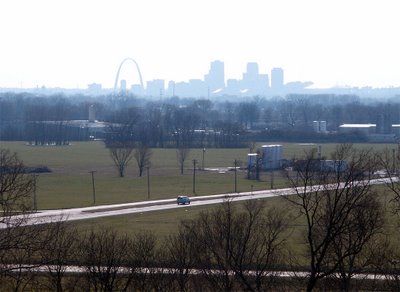
The Nile River in Egypt is famous for its pyramids, but the Mississippi River has its pyramids too, in particular this one, Monk's Mound, near Collinsville, Illinois. This soil pyramidal mound is about 16 acres in area and 100 feet tall. It is the largest of the Cahokia Mounds, and indeed is probably the largest prehistoric mound in the hemisphere.
This pre-Columbian city dates from ca. A.D. 1050 to A.D. 1300, and was the largest in North America. Although scholars have various theories of the city's demise, usually related to overpopulation, none mention that human sacrifice may be the reason for the fall. Also, the area is in the American Bottom floodplain: one major flood could make the area unlivable. No written or oral history exists of this city's fate.
The mound gets its name from a Cistercian Order of Strict Observance (Trappist) monastery built there in 1809. Eighty monks from La Trappe, France, made their home on 400 acres on and around the mound. The monks left in 1814 after epidemics of malaria and typhoid fever killed about half of their community; the survivors moved back to France.
Other early travelers noted that this swampland was unhealthy, yet excellent for agriculture. Since that time, these wetlands have been aggressively drained with numerous canals, and protected from the Mississippi with high levees. This region now hosts the smokestack industries in the Saint Louis metropolitan area.

Downtown Saint Louis, Missouri, about eight miles away, as seen from the top of the mound.
Photos taken in March, 2006.


Was this mound underwater during the great flood of '93? I seem to remember that the midwest had become an inland sea that year.
ReplyDeleteThe mound area did not flood, which is very fortunate.
ReplyDeleteThe East Saint Louis levee, which protects the mounds, came within 5 feet of overtopping: if the levee failed, 71,000 acres of urban area would have been underwater, making this a disaster on the order of Hurricane Katrina.
thanks for post
ReplyDelete